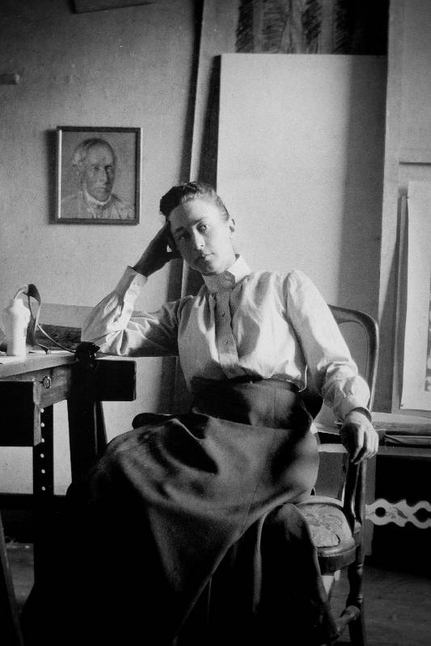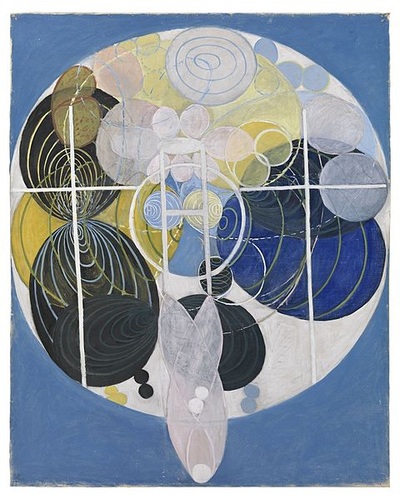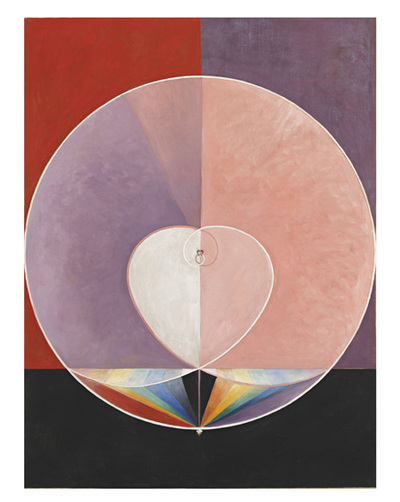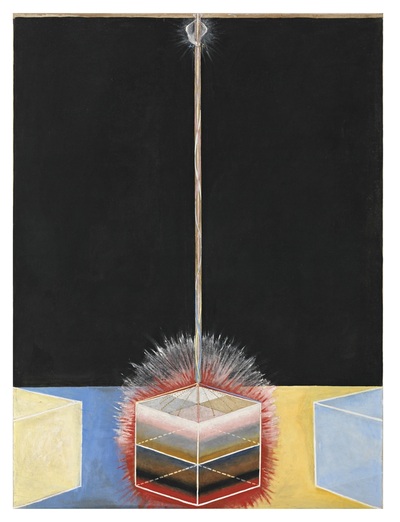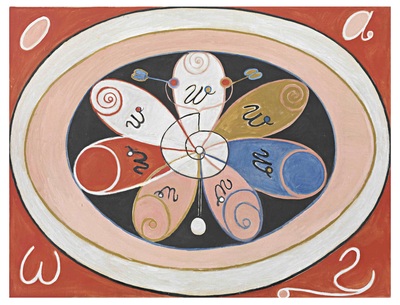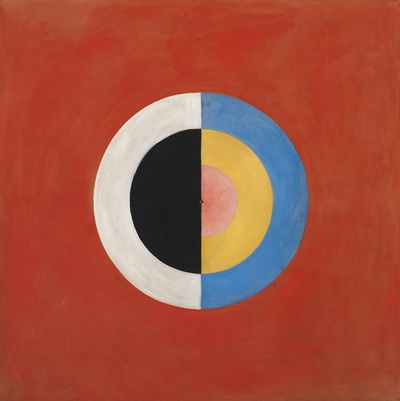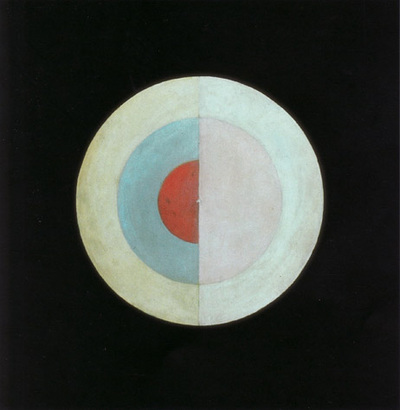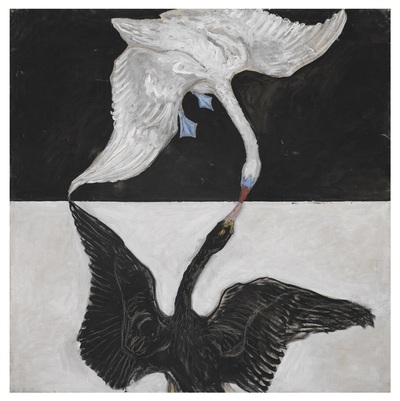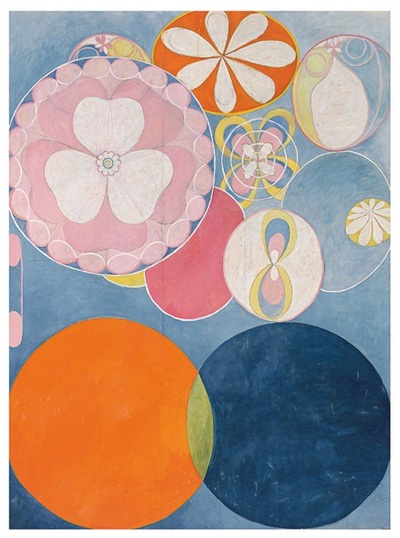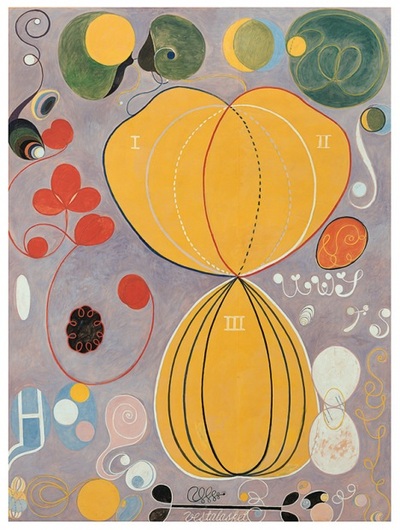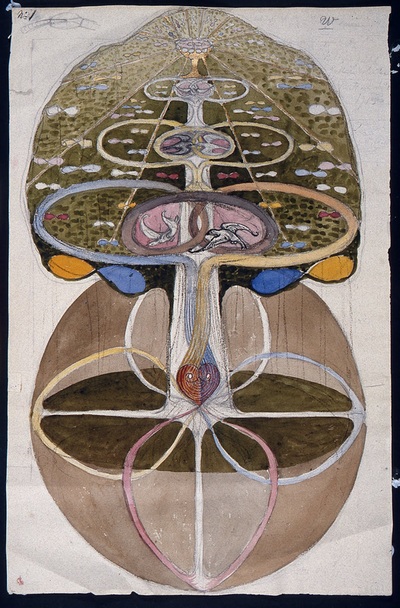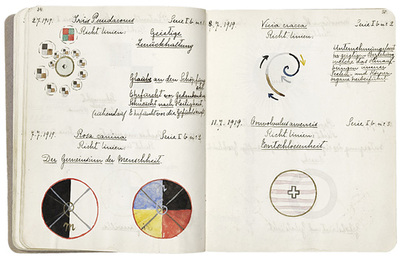HILMA AF KLINT 1862 - 1944
The Swedish artist Hilma af Klint was one of the women who were granted access to an education at an art academy, and subsequently were able to make a living off of selling their paintings in the 19th century. Parallel to her publicly known work—landscapes, portraits and still lifes in a naturalist style—starting in 1906 Klint also worked on another oeuvre, which she did not exhibit during her lifetime, and planned to have shown publicly at the earliest 20 years after her death. This second body of work comprises more than 1,000 pieces, which the artist understood as a cohesive picture cycle, and for which she did not see appreciation maturing in her day and age. For its future presentation, af Klint envisioned a building in which her individual series of drawings and large-scale paintings would form an interconnected ensemble along a spiral course. In the 1980s this secret oeuvre of af Klint’s became well-known internationally. In the exhibition “The Spiritual in Art. Abstract Painting 1890-1985,” Maurice Tuchman placed af Klint’s artworks in the context of the abstract avant-garde, for af Klint found her way to non-representational art before Kandinsky, Mondrian and Kupka. The first large retrospective of af Klints work, shown 2013 in Stockholm, Berlin and Málaga, painted an even more unusual picture. It became yet clearer that af Klint’s “abstract oeuvre” took formal steps in painting that one generally ascribes to the second half of the 20th century, for instance blending figuration, abstraction and writing, or the compartmentalization of a single homogeneous visual field into several semantic layers. Furthermore, the artist’s notebooks disclose that the process-based picture series are stations of inner perception as well as the result of an internal dialogue. Af Klint viewed her pictures as panels of an “other knowledge,” which was imparted to her through her communication with the “High Ones,” as she called her counterparts in her inner visions. But af Klint’s artistic practice does not match the cliché of the ethereal artist: She recorded and investigated her inner journies with the precision of a scientist. If one concurs with Gertrud Sandqvist’s characterization, af Klint’s communication with the “High Ones” bears witness to humor and sensuality: Thus according to af Klint, the physical orgasm is only a foretaste of the beatitude that could arise on these other levels of consciousness in expanded perception. The radicality with which af Kint pursued her secret work and kept it from the public of her time also raises the question of whether we are the present for which these pictures were made. Apart from the appreciation for an exceptional artistic oeuvre, the challenge is probably also to find a language for the extraordinary, yet all too ordinary experiences of the ecstatic reality which led af Klint to her body of work. Lina Launhardt Translated by Zoë Claire Miller Scroll down for German version Sources: Ake Fant: The Case of the Artist Hilma af Klint, in: Maurice Tuchman (Hrsg.): The Spiritual in Art: Abstract Painting 1890 - 1985, Katalog zur Ausstellung im Los Angeles County Museum of Art, Abbeville Press Publishers New York, 1986 Iris Müller-Westermann, Jo Widoff (Hrsg.): Hilma af Klint - Eine Pionierin der Abstraktion, Katalog zur Ausstellung im Hamburger Bahnhof - Museum für Gegenwart, Berlin, 15.6.-6.10.2013, Hatje Cantz, Ostfildern 2013 Daniel Birnbaum, Ann-Sofi Noring (Hrsg): The Legacy of Hilma af Klint: Nine Contemporary Responses. Moderna Museet and Koenig Books, 2013 Julia Voss: Hilma af Klints abstrakte Malerei - Die Kunstgeschichte muss umgeschrieben werden, FAZ, 24.02.2013 http://www.faz.net/aktuell/feuilleton/kunst/hilma-af-klints-abstrakte-malerei-die-kunstgeschichte-muss-umgeschrieben-werden-12086270.html Gertrud Sandqvist: Hilma af Klint and the Contemporary Art, in: Colourful Images - Past and Present Perspectives on the Work of Hilma af Klint - Lectures & Synopses An International Symposium arranged by Axel and Margaret Ax:Son Johnson Foundation, together with Hamburger Bahnhof - Museum für Gegenwart - Berlin, 4.Oktober 2013 Hilma af Klint - Abstrakt pionjär |
HILMA AF KLINT 1862 - 1944
Die schwedische Künstlerin Hilma af Klint war eine jener Frauen, die im 19. Jahrhundert zum Studium an einer Kunstakademie zugelassen wurden und anschließend von dem Verkauf ihrer Malerei auch leben konnten. Parallel zu ihrem öffentlichen Werk – Landschaften, Portraits und Stillleben im naturalistischem Stil – arbeitete af Klint ab 1906 an einem weiteren Œuvre, das sie zu Lebzeiten nicht ausstellte und frühestens 20 Jahre nach ihrem Tod für eine Öffentlichkeit vorsah. Mehr als 1.000 Arbeiten umfasst dieses zweite Werk, von der Künstlerin als ein in sich geschlossener Bildzyklus verstanden, für den sie in ihrer Gegenwart noch kein Verständnis reifen sah. Für dessen zukünftige Präsentation schwebte af Klint zudem ein Bau vor, der die einzelnen Serien von Zeichnungen und großformatigen Leinwänden in einem spiralförmigen Rundgang zu einem großen Werk zusammenfügte. In den 1980er-Jahren wurde dieses geheime Werk af Klints international bekannt. Im Rahmen der Ausstellung The Spiritual in Art. Abstract Painting 1890–1985 stellte Maurice Tuchman Arbeiten von af Klint in den Kontext der abstrakten Avantgarde, denn af Klint fand bereits vor Kandinsky, Mondrian und Kupka ihren Weg in die Ungegenständlichkeit. Die erste große Retrospektive zu af Klints Werk, die 2013 in Stockholm, Berlin und Málaga zu sehen war, zeichnete ein noch ungewöhnlicheres Bild. Es wurde umso deutlicher, dass af Klints „abstraktes Œuvre“ formale Schritte in der Malerei unternimmt, die man gemeinhin in der zweiten Hälfte des 20. Jahrhunderts verortet, wie das Ineinanderblenden von Figuration, Abstraktion und Schrift oder auch die Aufsplitterung eines einheitlichen visuellen Feldes in mehrere semantische Ebenen. Weiterhin geben die Notizbücher der Künstlerin darüber Auskunft, dass die prozesshaften Bildserien Stationen einer inneren Wahrnehmung sowie das Resultat eines inneren Dialoges sind. Af Klint sah ihre Bilder als Tafeln eines „anderen Wissens“, das ihr über ihren Austausch mit den „High Ones“ vermittelt wurde, wie sie ihre Gegenüber nannte, die sie in ihrer inneren Schau wahrnahm. Dabei passt af Klints künstlerische Arbeitsweise nicht in das Klischee der entrückten Künstlerin: Mit der Genauigkeit einer Wissenschaftlerin protokollierte und erforschte sie ihre inneren Reisen. Folgt man der Darstellung von Gertrud Sandqvist, zeugt af Klints Austausch mit den „High Ones“ darüber hinaus von Humor und Sinnlichkeit: So sei nach af Klint der physische Orgasmus nur ein Vorgeschmack auf jenes Glücksempfinden, das sich auf diesen anderen Bewusstseinsebenen einer erweiterten Wahrnehmung einstellen könne. Die Radikalität, mit der af Klint ihr geheimes Werk verfolgte und der damaligen Kunstöffentlichkeit entzog, stellt auch an uns die Frage, ob wir die Gegenwart sind, für die diese Bilder gemacht wurden. Neben der Würdigung eines außerordentlichen künstlerischen Œuvres besteht die Aufgabe wohl auch darin, eine Sprache zu finden für die außeralltäglichen, allzu täglichen Erfahrungen jener ekstatischen Wirklichkeit, die af Klint zu ihren Bildern geführt hat. Lina Launhardt Quellen: Ake Fant: The Case of the Artist Hilma af Klint, in: Maurice Tuchman (Hrsg.): The Spiritual in Art: Abstract Painting 1890 - 1985, Katalog zur Ausstellung im Los Angeles County Museum of Art, Abbeville Press Publishers New York, 1986 Iris Müller-Westermann, Jo Widoff (Hrsg.): Hilma af Klint - Eine Pionierin der Abstraktion, Katalog zur Ausstellung im Hamburger Bahnhof - Museum für Gegenwart, Berlin, 15.6.-6.10.2013, Hatje Cantz, Ostfildern 2013 Daniel Birnbaum, Ann-Sofi Noring (Hrsg): The Legacy of Hilma af Klint: Nine Contemporary Responses. Moderna Museet and Koenig Books, 2013 Julia Voss: Hilma af Klints abstrakte Malerei - Die Kunstgeschichte muss umgeschrieben werden, FAZ, 24.02.2013 http://www.faz.net/aktuell/feuilleton/kunst/hilma-af-klints-abstrakte-malerei-die-kunstgeschichte-muss-umgeschrieben-werden-12086270.html Gertrud Sandqvist: Hilma af Klint and the Contemporary Art, in: Colourful Images - Past and Present Perspectives on the Work of Hilma af Klint - Lectures & Synopses An International Symposium arranged by Axel and Margaret Ax:Son Johnson Foundation, together with Hamburger Bahnhof - Museum für Gegenwart - Berlin, 4.Oktober 2013 Hilma af Klint - Abstrakt pionjär |
